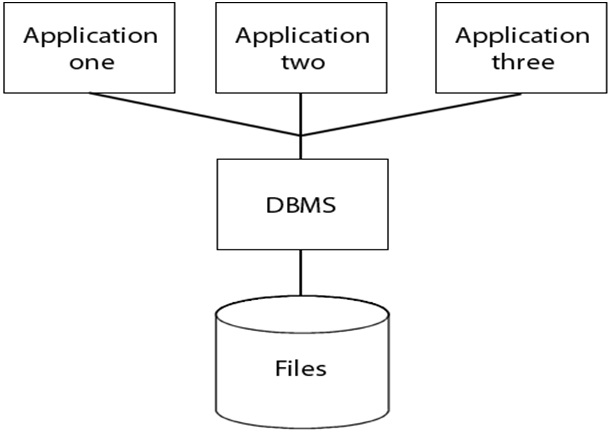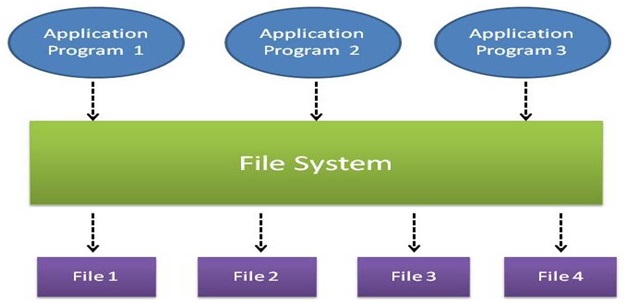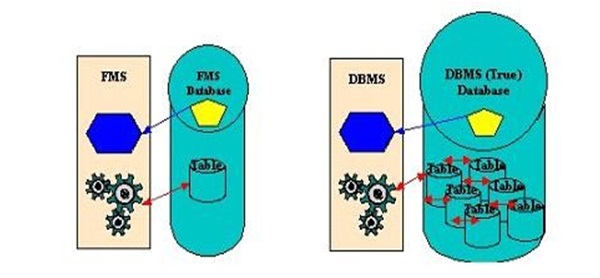Home »
DBMS
Difference Between DBMS and Traditional File System
DBMS Vs. Traditional File System: In this tutorial, we will learn what is DBMS and traditional file system, what are the differences between DBMS and traditional file system?
By Bharti Parmar Last updated : May 26, 2023
Introduction
DBMS and Traditional file system have some advantages, disadvantages, applications, functions, features, components and uses. So, in this article, we will discuss these differences, advantages, disadvantages and many other things. If you have any doubt, feel free to ask in the comment section.
So, let's get started to discuss DBMS and Traditional File System in detail. Then after, we will discuss the difference between them.
DBMS (Database Management System)
We have to know about what is data, database, and management first for knowing more about DBMS. So, Data is a collection of facts and figure that can be recorded; it can be in text, number, speech, video, image. Database means a huge amount of inter-related data is stored, retrieved and collect at one place in the database; In short, it is a collection of inter-related data stored in the database. Management is a collection of the program for security manage, retrieved and stored the data.
After knowing about data, database and management you can assume that what is DBMS. So, Basically DBMS is a collection of interrelated data's stored in a database server; these data's will be stored in the form of tables. The aim of the database is to provide a way to store and retrieve database information in a fast and efficient manner. database system not only contains data's but it contains a complete definition or description of the database structure and constraints.
The first DBMS introduced by IBM in 1960's named Apollo (mission for moon). DB2 is the famous open source code (in which we can modify the code) and free source code (where code cannot be changed but, we can use it with its source code) database. EF-CODD (Father of RDBMS) was the first who describe database function and create a first latest version of the database; which follows their 11.5 rules in 12 rules which are known as 12 rules of EF-CODD.

Components of DBMS
Hardware, Software, data manager (Command Checker), DB Engine, User, Data Dictionary (Structure), Data, Database, Database access language, Query Processor (Find and solve queries), Server, Run Time Manager.
Applications of DBMS
Airlines, Universities, Banking, Wave, Human Resources, Manufacturing, and selling etc.
Uses of DBMS
- Effective and efficient management of data.
- Query processing and management.
- Security and integrity of data.
- Data sharing and storage.
Advantages of DBMS
- Less space consumes.
- Reduction of redundancy.
- Data integrity, security, and continuity.
- Backup and recovery process.
- The data model can be developed.
- Concurrency control.
- Data independence.
- Performance is good.
Disadvantages of DBMS
- Required large size of memory.
- Time-consuming.
- Required a processor with the high speed of data processing.
- Cost of data conversion.
- Database failure (DB corrupted due to power failure or whole system stops).
- Expensive.
- Complex.
- Higher impact of a failure (if any component can bring the operation to a halt).
- Cost of DBMS (depend on the environment, function or recurrent annual maintenance cost.
Functions of DBMS
- Data dictionary management.
- Modify, delete, insert the data.
- Security.
- Control multi-user access management.
- Achieved data integrity.
- Transaction management.
- Data transformation and presentation.
Features of DBMS
- Persistence – permanent data stored.
- Validity – validation of field.
- Consistency – the value of data is the same at all place.
- Security.
- Non-redundancy – no multiple copies.
- Independence.
- Concurrency – multiple users can share a file at same time
Traditional File System
Before the use of a computer, a manual file system was used to maintain the records and files. Data were stored and processed using a traditional file system and it makes it easy to find any information. In this traditional file system, each file is independent of other file and data in the different file can be integrated only by writing an individual program for each application. The data and application program that uses the data are arranged that any change to data requires modification of all the programs that use the data. Sometimes, it is not possible to identify all the programs using data and identified on trial and error basis. All functional areas in the organization create, processes its own files.
The files such as inventory and payroll generate separate files and do not communicate with each other. The organization was simple to generate and had better local control but the data of an organization is dispersed throughout the functional subsystem.

Components of Traditional File System
Hardware, Software, data manager, DB Engine, User, Data, Database, Database access language, Server, Run Time Manager.
Applications of Traditional File System
The application is developed for a specific purpose and they will access the database only.
Uses of Traditional File System
- Language-specific run-time libraries
- User programs use file system APIs to make requests of the file system
- Data transfer
- Positioning.
- Updating metadata
- Managing directories.
- Managing access specifications.
- Removal
Advantages of Traditional File System
- Simple to use.
- Less complex.
- Minimal investment (Not make the investment in software because it allows us to transport files from one to another computer).
- No requirement of the specialist.
Disadvantages of Traditional File System
- Data redundancy (Each application has its own data file so, same data may have to be recorded and stored in many times).
- Data inconsistency (Due to the same data items that appear in more than one file do not get updated simultaneously in each and every file).
- Data dependence (Program and application in the file processing system are data dependent but, the problem is incompatible with file format).
- Limited data sharing.
- The problem with security.
- Retrieval (retrieval is not easy).
- Time-consuming.
- Inefficient to maintain the record of the big firm having a large number of items.
- Required Lots of labor work to do.
Functions of Traditional File System
- Store and arrange the computer files.
- Stored files into database, manipulation, and retrieval by the computer's operating system.
- Perform services for the end-users, such as updating, insertion, deletion adding new files to database etc.
- Each program defines and manages its data.
Features of Traditional File System
- It stores data in a group of files.
- Files data are dependent on each other.
- C/C++ and COBOL languages were used to design the files.
- It is very difficult to maintain the traditional file processing system.
- The traditional file system is also called a flat file system.
Difference Between DBMS and Traditional File System
The following are the key differences between DBMS and traditional file system:
- DBMS is very expensive but, the traditional file system is cheap.
- DBMS is good for the large system but, the traditional file system is good for a small system having a small number of items.
- DBMS required lots of effort for designing but, the traditional file system is very low design efforts.
- DBMS is highly secured but, the traditional file system is not secure.
- DBMS is data sharable but, the traditional file system is isolated data sharable.
- DBMS is flexible but, the traditional file system has a lack of flexibility and has many limitations.
- DBMS has no integrity but, the traditional file system has an integrity problem.
- DBMS has a complex backup system but, the traditional file system has a simple backup system.

Conclusion
In this article we have case studied the DBMS, Traditional file system and their components, features, functions, advantages, disadvantages, uses, applications and differences between DBMS and Traditional file system. After reading this article, you can correlate the differences between them. Stay tuned for the next article. We will dig deeper and discover more about DBMS. See you in the next Article! Happy Learning!
Advertisement
Advertisement